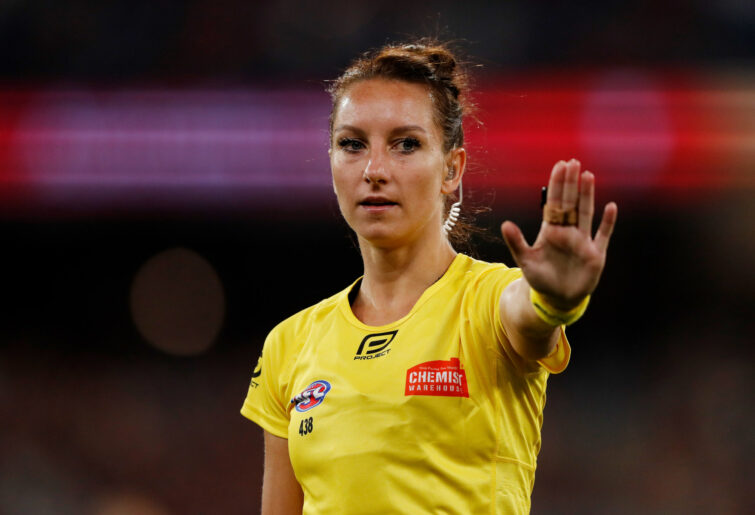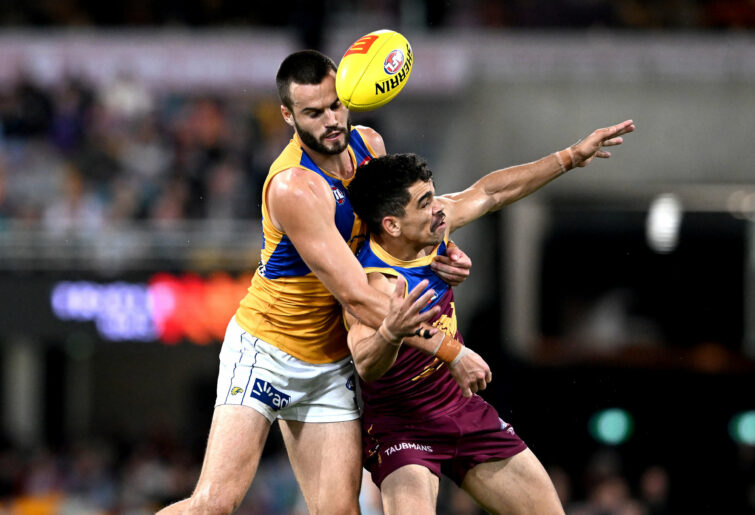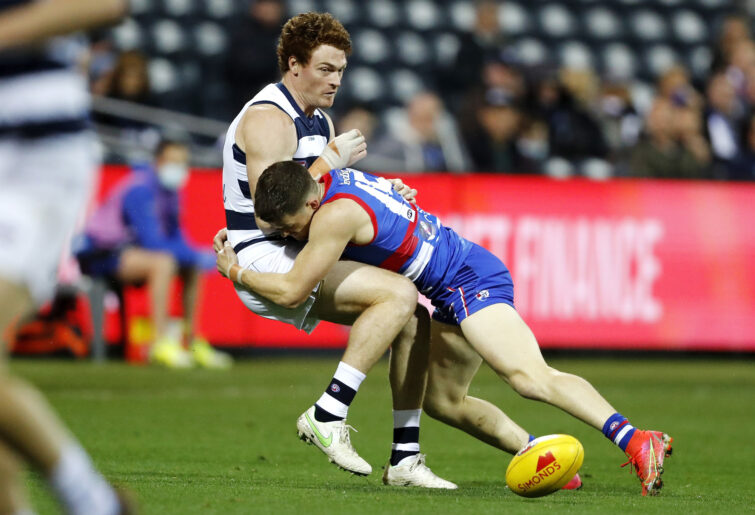It’s good to see the umpires getting a right old whack for their umpiring.
I don’t care about the quantity of free kicks awarded. Idiots complain about the quantity of free kicks. Quantity should neither be mediated nor capped; it’s purely an outcome of what’s happening, and with that being the qualification, it could have wild swings from game to game depending on what’s happening.
The biggest problem is consistency.
It’s not just from season to season, from round to round, from game to game or even from quarter to quarter.
The problem is from incident to incident.
You’ll see it so frequently. A decision is paid and then not two kicks later you see the same thing happen and it’s ignored.
Why are interpretations so malleable?
Is it because we have a sport where we bandy new rules every year, tweak interpretations endlessly and have created so many grey areas that the game itself has become a Bermuda Triangle of enigmatic outcomes? Yet we deign umpires as sacrosanct, and therefore examination never burrows very deep. Without examination, there’s no real improvement. Why would there be when there’s limited accountability?
To be fair (to the umpires), the AFL just stonewalls complaints until we capitulate and just accept inexplicable interpretations as idiosyncrasies of the game. Instead of criticism, we consign schizoid interpretations to the realm of novelty and view such incidents with wry amusement. Eventually we stop commenting.
Which is exactly how we’ve arrived at this mess.
“It’s a hard game to umpire,” we’re told.
Well, it is when the rules, interpretations and expectations are so unstable in nature.
I’m not blaming the umpires. I’m glad they’re getting a whack, because it’s drawing the focus back to the rules.
But the mandates come from higher above.
Here are all the rules that are broken.

(Photo by Dylan Burns/AFL Photos via Getty Images)
Kicking in danger
Does it exist? Doesn’t it? It happens so often throughout a game that a player will kick the ball just as an opponent’s about to grab it, but only the odd exception is paid to remind everybody that the rule exists. It’s up there with Bigfoot sightings and yet somehow has less credibility.
The AFL should either honour the rule or do away with it entirely.
Of course, if they did away with it entirely, we’d be rewarded with a plethora of broken fingers and broken hands, at which time the AFL will decide to reconstitute the rule.
It’ll be like a dog eating its own vomit.
Deliberate
This has become farcical. Any time a player kicks, handballs or punches the ball out of bounds and a teammate isn’t in the vicinity, it’s deliberate.
Let’s forget that sometimes players are just clearing the ball from defence with a blind kick or soccering it along or punching it to stop an opponent from getting it. There is any number of legitimate reasons that a player might move the ball on from the immediate area. But if it goes out, then that must’ve always been the player’s sole intent. Forget everything else.
The AFL has made this an arbitrary rule that ignores common sense and disposes of context.
And surely it’s a horrible look – if not contrary to the spirit of the game – to watch the opposition allow the ball to go over the boundary line or chaperone it over or turn and appeal to umpires before the ball’s even gone out.

(Photo by Dylan Burns/AFL Photos via Getty Images)
The deliberate rushed behind
Does this exist anymore? Well, it’ll show up with the frequency of Halley’s comet and then be gone again for just long.
This was one of the great overreactions. Hawthorn rushed behinds in the 2008 grand final. Well, they did that because the AFL changed another rule: previously the player kicking out had to wait for the goal umpire to stop waving his flags. Once that was done away with, a player could rush, relieve pressure and then kick out before the opposition had time to reset their zones.
Then there was the Joel Bowden incident. In a tight game against Essendon, Bowden had no idea where to kick it out. The umpire called play on. Bowden’s opponent rushed him. Bowden stepped the ball back over the line for a rushed behind – smart play, really. But AFL deemed this must never happen again because it was such a bad look – which makes it ironic they’d introduce a different bad look. However, instead of disallowing the player kicking out to rush it, they deemed that rushing as an act should be illegal.
What is wrong with a rushed behind? It comes with an automatic penalty – the score of one behind. Last time I checked, teams could win a game by one behind.
Holding the ball 1: dragging the ball in
I have no problems pinging a player who dives on the ball and drags it in being penalised for holding the ball.
What I abhor is when a pyramid of players forms and despite the player on the bottom being unable to physically move, let alone dispose of the ball, they’re somehow pinged.
I would like the AFL to demonstrate how the player could possibly move, let alone dispose of the ball, in such situations.
There are plenty of times a player tries to move the ball on but is beset and then has no hope of doing anything.
Don’t worry about that, though. He (or she) is on the bottom, so they must be guilty.

(Photo by Matt King/AFL Photos/via Getty Images)
Holding the ball 2: no genuine attempt
So what the umpires have been instructed to look for is genuine mimicry that a player is attempting to dispose of the ball, even if they can’t. But if they’re pretending they’re trying, that’s all that’s important.
Dismiss the reality that the ball’s held to them and they can’t dispose of it so they don’t bother mimicking.
Pantomime is the priority.
This borders on a whole new level of stupid.
Holding the ball 3: dropping the ball/illegal disposal
How many times do you see players legitimately tackled, only to drop the ball? Or throw the ball? We have games where there are 80 tackles and yet maybe five holding-the-ball decisions paid. Wow. That team must be appalling at tackling to convert so few of those tackles into free kicks.
Or perhaps the simpler truth is that these just aren’t paid often enough – because somebody (hint: it’s the AFL) wants the ball constantly in motion.
The amount of illegal disposal during any game is rampant. And screw ‘prior opportunity’ as a defence. If you drop it or throw it, you should be pinged regardless.
Push in the back
Why do I constantly hear it’s okay to push somebody in the back as long as you don’t use your hands? A push is a push.
What confused the interpretation is the fleeting introduction of ‘hands in the back’ as a penalty. How long did that last? Just long enough to convince some morons that a push is only an issue when hands are involved.
And now we have frequent pushes in marking contests and irregular penalties.

(Photo by Bradley Kanaris/Getty Images)
Ruck infringement
Two ruckmen tangle up, the umpire blows the whistle and nobody – nobody – knows which way it’s going to go.
How long has this existed? And nobody calls outs the stupidity of allowing it to prevail. Nobody demands clarification.
This is the standard-bearer of nonsense interpretations that we’ve stopped questioning.
Taking the legs out
A player dives in to win the ball and handballs it out perfectly to a teammate but is penalised for taking out an opponent’s legs in the process.
Here’s the big problem with this rule: a player should never be deprived of an option to impact (or win) a contest. For example, the ball is kicked into the forward 50. A defender has the option to punch or mark. Each option might have a different probability of success. The defender must choose what they think is their best option.
In this case the player’s only alternative to attempting to win a ground ball is to hold back and let an opponent take possession instead.
How is that right?
Of course the AFL decided that because one player had his leg broken when an opponent slid in knees-first – which used to be the qualifier but has long since been discarded – they need to ensure this never happens again.
Now we have this fun grey area. Did the player take the legs out? Was he taken high? Is it not paid at all?
Well, who knows?

Gary Rohan is tackled by Taylor Duryea. (Photo by Dylan Burns/AFL Photos via Getty Images)
The stand rule
So the ball-carrier can pretend to set off, arc around the man on the mark, do the lambada, but should the man on the mark blink, it’s a 50-metre penalty.
Hmm. This seems perfectly reasonable. Let’s go back to giving an opponent an option. Previously the man on the mark could bounce around and try to throw the ball-carrier off. As long as he didn’t cross the mark, he was fine.
Not anymore. “Stand,” the umpire tells the player, like he’s a dog being taught to stay.
The biggest problem with this rule is that it wasn’t introduced to address issues with the man on the mark. It was introduced to try to speed up ball movement and decrease the possibility of congestion – the AFL were finding a way to give the ball-carrier greater freedom, speed and distance to move the ball, which meant limiting the defensive accountability of the man on the mark.
The protected area
I appreciate the need to protect the ball-carrier’s options, but how often does some opponent drifting past impinge upon the ball-carrier’s options? Yet a 50-metre penalty is awarded.
Just like the stand rule, this exists as a means to create space and distance and diffuse any potential congestion.
Players need to be allowed to maintain their zones or mind opponents rather than being told to stay out of the way.
It’s such an easy fix: if an opponent legitimate impinges upon the ball-carrier, award the 50. If not, let the game go.
Umpire dissent
This is already so hideously inconsistent that it’s quickly become an aberration.
Why shouldn’t a player be allowed to question an umpire for clarification? Why shouldn’t a player be allowed to throw their arms up in frustration?
Who is this hurting other than the AFL’s belief that player backchat and gesticulations are discouraging the next generation of umpires from taking up the game? God forbid we teach that next generation how to defuse potential volatility, manage the situation and build a rapport with players. Just let’s make sure it never happens.
It’s fine if the AFL want to penalise overt demonstrations, but for God’s sake let the players be human and be able to exclaim like we all do when some situation exasperates us.
‘It’s a hard game to umpire’
Again, that’ll be the defence. The reality is the interpretations vary so extremely from game to game and the templates for decisions are so inconclusive that it’s no shock the game’s such a mess.
There are thousands of hours of archival footage. It can’t be hard to find concrete examples that can act as guides as to how rules and their interpretations should look.
Instead of trying to make the rules arbitrary and colouring in all grey areas so they become black or white, how about we teach umpires what rules look like, how to interpret context and, when needed, apply common sense?
If we all understood the filter required, we’d all happily find that middle ground.
But instead, let’s not only allow but enable interpretations to fluctuate wildly from moment to moment.
I’m sure that’ll keep working out.

































































































